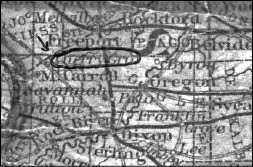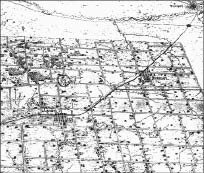
Discover rewarding casino experiences. 
|
Wild cherry trees bordered the timbers and sparkling runs to locate the second settlement in Carroll County, 1830, when Tom Crain, a southern Illinoisan, made a Cherry Grove squatter’s claim. Cherry Grove was about as close to sentimentalism as a hard-bitten frontiersman would get but whose love for the land ran deep. As it developed, Cherry Grove became quite an important center in the planning for the future of the entire county. Forget the lead mines, look around. The prairies and timbers were limitless in their potential. Exploit the growing trade coming in to Savanna port. Raise produce and livestock to send out. Build the necessary mills to grind the grain everyone had to have. Important meetings took place at Cherry Grove House, the well set-up hotel on the busy stage coach route that had replaced Crain’s Fort as the center of things-going-on on the east side of Carroll County. Cherry Grove Inn and surrounds was one of the three voting precincts in the county and although at the first election there were but 212 votes cast (only males voted then) and 127 of them were in Savanna precinct, the other eighty-five were influential too! They got the county seat eventually moved to Mt. Carroll from Savanna, formed a mill company at the mount to draw trade there, talked churches, schools, politics, etc. Yet in 1840 it was the only stopping place on the eastern side of the county and competing with Elkhorn Grove in numbers.
Among the leaders, reference says, was John C. Owings whose abilities were beyond the ordinary. He had a thriving trading post at the southwestern edge of the grove that was just like the trading posts seen in all later western movies ... Calicos, beads, kerchiefs, whiskey, blankets, guns, ammo, gear for frontier living; the works. There were many Indians yet in the area, peaceful and content to reside in their ancient homelands or return the next couple of decades to visit their burying grounds to pay tribute to their ancestors or gather ginseng and wild plants they knew. Owings’ son is said to have adopted the ways of the native American by dressing like them and going off with them on their walkabouts. After living here almost forty years the family took off for the Iowa frontier in 1868 to bring order to another wilderness. It is believed that Owings’ trading post was perhaps in Section 27, Freedom Township, a high elevation on which the log cabin post was built and in which a lamp or candle burned all night through to guide the traveler through the trackless dark, a typical gesture of the Owings’. This individualist was said to have plowed a furrow from his Cherry Grove site to Buffalo Grove (near Polo) to aid the traveler, not only to the merchandiser(!) but bring some sense of security to the wanderer. Yes, much occurred in the Cherry Grove neighborhood that isn’t apparent in this day and age, but which affected the progress and development that we are experiencing today; too much to list here but someday! Waves of migrating peoples came in the 1830’s, some in the ‘40’s and another tide of newcomers looking for more land in the “crowded” East. Most were looking out for the future, as you might expect, among that, the railroad. Only rutted paths had led them here, sometimes not even that. By foot or horsepower. Canals were all the rage for awhile but their waterways were limited to their streambeds or an expensively dug ditch. It was just about the time when the first settlers appeared in the Northwest that talk became serious about railroads here in Illinois. By 1836 the legislature approved formation of the “Illinois Central” railroad, it reaching from Cairo at the southern tip to Galena in the north. You know that story. It went broke the first time. A deep depression in 1837 stopped most everything for several years but by the 1850’s the prospects looked even higher ... The advantages of a railroad were the growth of agriculture, industry, employment ... Just like Today’s technological hype.
Train engines in those days had names to honor some local dignitary such as in Illinois’ case, the “Rogers.” It was shipped by water from New York to New Orleans, up the Mississippi by steamboat to Meredosia to make the claim of the inaugural engine in the state ... It had one set of two foot diameter drive wheels, no closed cab, no whistle, no bell. But it was OUR train, Illinois. (In October of 1861, Lanark’s first train was named “D.W. Dame,” for the promoter of things railroad in that day. That was OUR train, Lanark, Illinois!) Within a few years, 1856, there was already 2,000 miles of track laid in Illinois, the Illinois Central being the longest stretch of track in the world—705 miles from Chicago to the Gulf of Mexico. Chicago quickly became the hub of railroads going and coming ... One hundred trains a day passed in and out of Chitown. Every neighborhood in the country cried Railroad, not just towns, neighborhoods, Cherry Grove being one of them. Farms were producing crops beyond imagination, livestock healthfully reproduced. Men who would be merchants anted to buy and sell and needed a railroad to carry in and out. So many plats were drawn that rumors abounded! Who would be next?
The Savanna Branch Railroad was first given approval to form a company in November of 1849. In Illinois while the Wisconsin legislature permitted the Racine, Janesville & Mississippi Railroad to organize in June of 1853. They eventually merged interests. Railroads were very expensive to build and operate and it took plenty of money for a long one such as would run from Lake Michigan to the Mississippi River over varied terrain and with most of the equipment and machines manufactured at distances. Plus few spare parts at hand. One anecdote tells of waiting for the tracks to come from Scotland because those produced in the U.S. were inferior. The strap iron rails would curl up to pierce the bottoms of the cars, injury, even killing passengers or crew. Sections and segments were built separately so it was slow going. The first company went bankrupt. Cherry Grove farmers who’d invested, lost thousands of dollars. The Carroll County courthouse has a record book nearly full of amounts and names of those investors mortgages. George Puterbaugh, Cherry Grove, was one. He was said to have lost $10,000. And that was just the first sortie into rail building through Carroll. Was it poor management? Lack of experience in rail building? Perhaps, a combination of many factors. But faith in the future was certainly a characteristic of those who felt the new form of transportation would be the answer to everything in the present. Build again. Remnants of that first failure are still to be seen ... A high embankment south of the Van Brocklin Church across the creek by the road’s curve in Stephenson County, the township curve in Section 30, Cherry Grove Township and a one-time dug-out spot in a field over west in Section 27, Freedom; landmarks to a failure, not just natural landscape occurrences. A few years elapsed. Other companies organized the agendas of which are very detailed in the 1878 Carroll County History for the curious to scan. D.W. Dame wrote it back then so it’s probably correct, he being a railroad promoter from ‘way back. Again in 1860 tracks were going to be laid. Shannon received them that year and the next year, 1861, Lanark became a market/depot, too. Farmer George Puterbaugh believed in the project so much that he again invested (mortgaged the farm) and, apparently took up the plat of “Town of Cherry Grove,” to name it for himself, Georgetown. Next, hopefully, a new village born.
|






